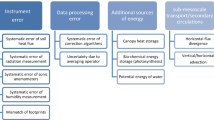Abstract
A one-dimensional atmospheric boundary-layer model is developed using the finite element method and a 1.5-order e-l turbulence closure scheme. A vertical adaptive strategy is implemented, based upon an heuristic error estimator that depends upon properties of the layer, such as the stratification. The model is used to simulate a moderately stratified stable boundary layer as described in the GABLS (GEWEX Atmospheric Boundary-Layer Study, where GEWEX is the Global Water and Energy Cycle Experiment) First Intercomparison Project, and then a more complicated diurnal cycle, as used in the GABLS Second Intercomparison Project. In the stable boundary-layer experiment, it is shown that including the adaptive strategy can improve the performance of the model such that the error in the model is significantly less (greater than an order of magnitude with an effective resolution of 8 m) than that of the model without adaptivity. The model’s turbulence closure scheme and the adaptivity strategy also successfully simulate the different stability regimes present in the diurnal cycle simulation, and represented all of the expected features.
Similar content being viewed by others
References
Andre JC, De Moor G, Therry G, Du Vachat R (1978) Modelling the 24-hour evolution of the mean and turbulent structures of the planetary boundary layer. J Atmos Sci 35: 1861–1883
Beare RJ, MacVean M, Holtslag A, Cuxart J, Esav I, Golaz J-C, Jimenez M, Khairoutdinov M, Kosovic B, Lewellen D, Lund T, Lundquist J, McCabe A, Moene A, Noh Y, Raasch S, Sullivan P (2005) An intercomparison of large-eddy simulations of the stable boundary layer. Boundary-Layer Meteorol 118(2): 247–272
Blackadar AK (1962) The vertical distribution of wind and turbulent exchange in a neutral atmosphere. J Geophys Res 67: 3095–3102
Burchard H, Beckers J-M (2004) Non-uniform adaptive vertical grids in one-dimensional numerical ocean models. Ocean Model 6: 51–81
Cuxart J, Holtslag A, Beare R, Bazile E, Beljaars A, Cheng A, Conangla L, Ek M, Freedman F, Hamdi R, Kerstein A, Kitagawa H, Lenderink G, Lewellen D, Mailhot J, Mauritsen T, Perov V, Schayes G, Steeneveld G-J, Svensson G, Taylor P, Weng W, Wunsch S, Xu K-M (2005) Single-column model intercomparison for a stably stratified atmospheric boundary layer. Boundary-Layer Meteorol 118(2): 273–303
Dietachmayer G, Droegemeier KK (1992) Application of continuous dynamic grid adaption techniques to meteorological modelling: Part I: basic formulation and accuracy. Mon Wea Rev 120: 1675–1706
Fiedler BH (2002) Grid adaption and its effect on entrainment in an e-l model of the atmospheric boundary layer. Mon Wea Rev 130: 733–740
Fiedler BH, Trapp RJ (1993) A fast dynamic grid adaption scheme for meteorological flows. Mon Wea Rev 121: 2879–2888
Galperin B, Kantha LH, Hassid S, Rosati S (1988) A quasi-equilibrium turbulent energy model for geophysical flows. J Atmos Sci 45: 55–62
Hanert E, Deleersnijder E, Legat V (2006) An adaptive finite element water column model using the Mellor-Yamada level 2.5 turbulence closure scheme. Ocean Model 12: 205–223
Hanert E, Deleersnijder E, Blaise S, Remacle J-F (2007) Capturing the bottom boundary layer in finite element ocean models. Ocean Model 17: 153–162
Holtslag B (2005) Preface: GEWEX Atmospheric Boundary Layer Study (GABLS) on stable boundary layers. Boundary-Layer Meteorol 118(2): 243–246
Jablonowski C (2004) Adaptive grids in weather and climate modelling. Ph.D. thesis, The University Of Michigan
Kosovic B, Curry JA (2000) A large-eddy simulation of a quasi-steady, stably-stratified atmospheric boundary layer. J Atmos Sci 57: 1052–1068
Liu CH, Leung DYC (1998) Evaluation of an atmospheric boundary layer model used for air pollution studies. J Appl Meteorol 37: 1561–1576
Mellor GL, Yamada T (1974) A heirarchy of turbulence closure models for planetary boundary layers. J Atmos Sci 31: 1791–1806
Piggott MD, Pain CC, Gorman GJ, Power PW, Goddard AJH (2004) h, r and hr adaptivity with applications in numerical ocean modelling. Ocean Model 10: 95–113
Poulos SG, Blumen W, Fritts DC, Lundquist JK, Sun J, Burns SP, Nappo C, Banta R, Newsom R, Cuxart J, Terradellas E, Balsley B, Jensen M (2002) CASES-99: a comprehensive investigation of the stable nocturnal boundary layer. Bull Amer Meteorol Soc 83: 555–581
Steeneveld GJ, van de Wiel BJH, Holtslag AAM (2006) Modelling the evolution of the atmospheric boundary coupled to the land surface for three contrasting nights in CASES99. J Atmos Sci 63: 920–935
Author information
Authors and Affiliations
Corresponding author
Rights and permissions
About this article
Cite this article
Dunbar, T.M., Hanert, E. & Hogan, R.J. A One-Dimensional Finite-Element Boundary-Layer Model with a Vertical Adaptive Grid. Boundary-Layer Meteorol 128, 459–472 (2008). https://doi.org/10.1007/s10546-008-9297-7
Received:
Accepted:
Published:
Issue Date:
DOI: https://doi.org/10.1007/s10546-008-9297-7




